Slings like a weapon
Everyone knows that David killed Goliath from the sling, but what is the sling in stories technology? In fact, the sling was used in war in Europe and the Middle East, at least from the Bronze Age and until the 17 century AD. Moreover, the sling was the favorite throwing weapon of many peoples, ancient and existing now, all over the world. In Mesopotamia, Persia, Greece, and Rome, it was considered equal for archers to be equal to archers. In this part of the world, the sling was probably known at the beginning of the Neolithic, about 10000 years ago, and, probably, was used at the end of the Paleolithic.
David’s victory over Goliath is often considered an allegory, but given the nature of military affairs during David’s time, this event may be best viewed as an example of the great skill of the slingers and their faith in their weapons. The story about this fight in Samuel’s First Book confirms this view. It should be remembered that David was the eighth son of Jesse. As the youngest son, he looked after the herds of the family. This occupation explains his ability to handle a sling; this weapon is still used by shepherds to protect their animals. David became a harper and a squire of Saul, king of Israel at the time of the Israelites' war with the Philistines. The army of opponents camped not far from each other. Every day the Philistine goliaf from Gath, a champion, “he is six cubits and an inch tall,” left the enemy camp and invited any of the Israeli troops to fight him and in this single combat decide the outcome of the war.
At the time when David came to the Israeli camp, not a single warrior from their camp for 40 days dared to accept the challenge of Goliath. David volunteered to fight Goliath, but refused the weapons and armor that Saul had laid on him. Further in the text:
“And he took his staff in his hand, and chose for himself five smooth stones from the stream, and put them in the shepherd's bag that was with him; and with a bag and a sling in his hand he came out against the Philistine. "
"And David put his hand into his bag and took out a stone from there, and threw it out of the sling and struck the Philistine in the forehead, so that the stone sank into his forehead, and he fell face down to the ground."
“Then David ran, and stepping on the Philistine, he took his sword and took it out of the sheath, and struck it, and cut off his head with it; When the Philistines saw that their strong man had died, they ran. ”
Goliath for the fight put on a full armor: a metal helmet, chain mail, metal leggings and a small shield over his shoulders. His squire walked in front of him with a big shield. The sword with which David cut off the head of Goliath is not described, but the pole of his spear was “like a warlock among weavers,” with a heavy tip. These weapons are quite similar to those of a hoplite, a heavily armed infantryman. It is intended for hand-to-hand combat; the spear is not thrown, but is used to strike or repel riders' attacks. The armor and weapons of Goliath, except, possibly, spears, were also suitable for single combat with the enemy, armed as well. However, they are absolutely not adapted for the pursuit of a mobile, not burdened by the armor of the enemy, and David, keeping his distance, was not exposed to particular danger.
David did not intend to approach the enemy, the sling was a long-range weapon. At the same time, no matter how David believed in the help of God, preparing for a single fight, he chose not one stone for sling, but five. If the first stone had not hit in the face, a vital, but unprotected place, which David must have been aiming for, would have four more stones at his disposal. In general, it is fair to attribute the victory of David not to divine intervention, but to his skill of the slinger.
David is the most famous, but not the only biblical slinger. Left handed whizards Benjamin (Judges) inflicted heavy losses on the Israelites, while David had selected warriors, “throwing stones at his right and left hand” (Chronicles). Why is the sling so rarely mentioned as a weapon? A definite clue can be found in the Iliad. In Homer's story about the siege of Troy, Locors, lightly armed warriors, hoping for their bows and a "twisted wave" are mentioned. However, the Greek word for mop, in the entire poem, occurs only once. And in this case, the sling is not mentioned as a weapon, but as an improvised bandage: one of the Trojan soldiers tied up the wounded arm of the other with an “artificially twisted wave, soft bandage, slander always under the ruler’s wearable”. Probably, the Greek Pelttes, lightly armed, who had in their ranks greats, throwers of darts [35] and archers, did not receive special recognition at a time when they considered the noble only a hand-to-hand fight between heavily armed warriors. Images of hoplites (and even archers and dart throwers) are fairly common, but images of slingers are rare.
At the same time, lightly armed troops played a crucial role in classical Greece. They tied the battle. The rain of darts, arrows and stones, which they brought down on the enemy, could make a dent in its ranks; at least, such a shelling could reveal weak points in the ranks of the enemy, which could be used by the advancing heavy infantry. Moreover, if the attack was unsuccessful, lightly armed could cover the retreat of heavy infantry. An army that entered the battlefield without Peltasts could have been considered defeated in advance.
We have reached a detailed description of the fate of such an army; in a short time she lost almost all of her lightly armed warriors. This army, which was the main force of an even larger army assembled in 401 BC. for the overthrow of the king of Persia, consisted of 10000 Greek heavily armed soldiers. After the claimant to the throne, who had led them, died in the battle of Kunaks, the claimant’s army of local contingents fled, and the Greeks were left alone. Xenophon, an Athenian, undertook to take the 10000 Greek infantrymen out of a hostile country, but on the very first day of the march they suffered so much from a few enemy riders, archers and sopers who were able to go through only the 25 stages, i.e. less than three miles On this night, Xenophon told the strategists: "We must immediately acquire slingers and horsemen."
"They say," continued Xenophon, "in our army there are Rhodians, who are told that many of them know how to shoot sling, and their shells fly twice farther than the shells of Persian slingers. The latter, after all, are shooting at a short distance, as they use stones in the girth, and the Rhodians are familiar with the use of lead balls. ”
Soon, Xenophon and his associates recruited slingers and a detachment of riders from 200 people on horseback from the 50 army. Having added these lightly armed to the squad of 200 Cretan archers, who were among the 10000 mercenaries, the Greeks successfully resisted the Persians pursuing them. The Cretan archers did not shoot as far as the Persian, but the Rhodian slingers, according to Xenophon, "shot the sling to a greater distance than the Persian slingers and archers." Considering that the Persian archers were then considered the best in the world, these words of his well illustrate the range of firing of Greek sopers.
What is the range of archery and sling? Roman military writer Vegetius, who wrote about 400 AD, recommended archery at a target from a distance of 180 meters. Even a modern sports bow with a capacity of 45 pounds is capable of shooting an arrow a little further than 200 meters. Using a long and light arrow of the “flight arrow” type and a bow with a capacity of 60 pounds, an archer, firing at a range, may be able to shoot an arrow at a distance of up to 275 meters. For comparison, I asked young people from eastern Turkey several times to throw ordinary pebbles from a sling. In five of the 11 cases, the projectile flew over the 200 meter mark, with the three best shots reaching the 230-240 meter. None of the young people made the impression of a skilled slinger; at least, none of them had a sling at the time. Moreover, the shells served as ordinary stones, smooth, selected at random, and not neatly processed stone, clay or lead shells used in antiquity. Based only on the evidence of Xenophon, it can be assumed that the sling could have thrown a lead shell to a distance of more than 400 meters.
The sling I mentioned was a manual one (Latin funda). There is one more type of sling - sling-pole (lat. Fustibalus). A sling can be a regular strap about 3 feet long and about an inch [37] wide. At one end of the strap is a loop, knot or brush, allowing the shooter to fasten this end of the sling on one of the four fingers of the throwing hand. The other end of the sling, on which you can make a knot for ease of grip, is held between the thumb and index fingers of the throwing hand. The shooter places the projectile in a pocket, sometimes specially enlarged, at the end of a hanging loop. A shell of stone or clay is usually the size of an egg. The circular motion of the brush causes the sling to rotate rapidly in a semi-horizontal (around the slinger's head) or a vertical (parallel to the body) plane. After three or four turns, the shooter releases the loose end of the sling, and the projectile flies out of the sling along the tangent to the circumference it describes.
Sling-pole allows you to throw at a distance smaller than a sling. At the same time, it is easier to handle and allows you to use projectiles bigger and heavier. The sling itself, usually made of rope, is attached at one end to a pole about 3 feet long. The free end of the sling is temporarily attached to the end of the pole; for this, either a recess is made at the end of the pole, from which the free end of the sling could slip, or a loop is made at the free end of the sling, allowing it to slide off the pole. The shell is placed in an enlarged pocket at the end of the hanging loop. Initially, the shooter holds the pole parallel to the ground, and then sharply flaps it vertically above his head; at the end of the stroke, the free end of the sling slides off and the projectile takes off [see illustration on the page opposite]. Such a sling was used in antiquity, and in the Middle Ages it became a popular siege weapon. Even after the appearance of gunpowder, still in the 17 century, it was used to throw grenades.
The longer the sling, within reasonable limits, the greater the potential velocity of the projectile. The inhabitants of the Balearic Islands, located east of Spain, were famous slingers. So, Polybius, 2's Greek historian. BC, claimed that it was because of this island got its name, because ballein in Greek means "to throw." Be that as it may, the Balearic slingers performed the role of light infantry in many wars of the classical period, to the greatest extent in the long war between Rome and Carthage. They always wore three slings of different lengths: long for throwing projectiles at long distances, short for short, and medium length for throwing at medium distances.
As for the shells, then, naturally, if these are just stones polished with water, it is not so easy for archaeologists to determine whether they are shells. Only in cases where a large number of similar stones have been found in a certain place, which, apparently, have not been used for other purposes (say, blocking something, or grinding), or, best of all, if they are not like stones, ordinary for the place of discovery, such stones can potentially be attributed to the sling shells used in a particular place in a certain period of time. Fortunately, although many natural projectiles may never be able to be determined, many projectiles were made with great care. They are not always easy to distinguish. Even in cases where they were identified, archaeologists sometimes had a question regarding the scope of application of such ordinary “clay eggs”.
In the Middle East, the first sling projectiles were spherical. They first appear shortly before the beginning of the sixth millennium BC. The following were biconical (biconical) projectiles [see top illustration on the 40 page]. A thousand years later, around 4000 BC, egg-shaped shells appeared. Apparently, with the improvement and standardization of projectiles, three main points were taken into account concerning the increase in firing accuracy. First, it was necessary to create equal-weight shells so that the slinger would not have to adjust to the projectile with each new throw. Secondly, it was necessary to create shells of a standard, somewhat streamlined [38] shape, in order to increase not only the accuracy, but also the speed and firing range. Thirdly, it was necessary that the projectile be placed comfortably in the sling's pocket, so that, as the Roman historian Livy said, “so that during the throwing the bullet does not roll, ... but firmly held the noose while swinging, and when throwing it flies out like a bowstring" .
In the manufacture of such stone shells of the desired shape, preference was naturally given to easily-processed materials, such as limestone. However, quite early, already in the pre-ceramic Neolithic period, some people realized the advantages of such material as clay. Clay shells are found in places of prehistoric and historical settlements around the world. So, earthen shells age approx. 7000 years found in Tel Hassuna, Iraq, and the same shells are found everywhere, not even hundreds, but thousands. In this case, the clay was not used at all due to the lack of suitable stones; clay shells are found in areas where there is enough pebbles.
Clay shells are interesting in two aspects. First, in almost all cases, they were dried in the sun, and not burned. Secondly, they are surprisingly heavy for their size. This is explained by two facts. To achieve maximum weight with a limited amount in the manufacture of such shells, chaff was not mixed into the clay, as is usually done for ceramic products and even bricks. The shells were made from pure clay (or, very rarely, from pebbles, covered with clay), and have an appropriate density. If such projectiles made of clay without impurities were burned with fire, they would have split from the heat and would become useless. Therefore, they were dried in the sun.
By the period of classical Greece, if not earlier, another type of projectile spread. They were made from lead. The Romans called them glandes, because of their resemblance to acorns. They were cast in molds and often inscribed; the same inscription on the inside of the form could have been stamped on hundreds of shells. The inscriptions were often standard: the name or number of the slinger's squad, the name of the belligerent, or the name of the commander. However, many inscriptions are informal. On one it says “Receive”; the other reads "Achaean strike"; the third one says “Your heart is Cerberus”; on the fourth - "Ass Pompey", and on the fifth simply "Oh."
As follows from a comparison with Xenophon of Rhodian and Persian slingers, standard shells differed greatly in size and weight. Measurements of biconical and egg-shaped shells found in the Middle East show how different they could be. The minimum weight is 13 grams, the maximum 185 grams. Depending on the size, the volume of the projectile could range from five cubic centimeters to about 65 (if the projectiles were of an ideal spherical shape, the corresponding diameters for such a volume would be from two to five centimeters, respectively).
In general, for such shells, stone, clay or lead, the variation in weight is usually less. Very few shells weigh less than 20 grams or more 50 grams. This is true, for example, for the Roman era. In 1885, the German scientist K. Zangemeister (K. Zangemeister) published, among other things, data on the mass of shells for sling found in Sicily and in Italy. He found that, on average, the lightest shells (from 24 to 46 grams) came from Sicily. The most heavy - from Askula, areas on the mainland, their average weight was more than 47 grams. The shells from the second terrain on the mainland, Perusia, had an average mass.
The shells that were sometimes used by Balearic slingers are a noticeable exception, even when compared to Middle Eastern shells with a maximum mass of 185 grams. Historian Diodorus, born in Sicily and writing in 1 c. BC, tells the story of the Battle of Eknome, where the army of Carthage, which included the 1000 lightly armed Balearic slingers, defeated the army of Agathocles of Syracuse. A significant role in the victory belonged to the same age. Diodorus writes that their stone shells were weight in a mine. A mine in our time is considered equivalent to 330 or 450 grams. Even if we take a more moderate lower figure (which also corresponds to the Roman pound and attic mine) and assume that the shells of Balearic sopers were made of limestone, each such stone will have a diameter of 6,3 centimeters, i.e. approximately with a tennis ball. These size and weight, perhaps, are the limit for projectiles made of stone.
How accurate were the slingers of the ancient Greeks and Romans, what was the striking ability of their shells? There is a lot of documentary evidence for this. Livy considers the best Achaean slingers. This is because, he believes, that the Achaeans train in accuracy, throwing projectiles in such a way that they fly through a small ring. [39] As a result of this training, Livy writes, the Achaeans "didn’t get into the head of the enemy soldier, but into the place of the person who was tagged." Immediately I recall the famous first shot from the sling of David.
Balearic slingers also owed their skills to special training. Diodorus writes that “mothers force small children to shoot from the sling every now and then, and the goal is the bread attached to the pole: the learner does not receive food until he gets into the bread - only then the mother allows him to take it and eat it”. The sons of Benjamin, the left-handed slingers mentioned in the Bible, were also accurate arrows from the sling: they "threw stones at the sling into their hair and did not throw it past."
As for the effectiveness of a sling as a weapon, it is worth noting that the speed of a projectile fired from a sling may well exceed 100 kilometers per hour. If we assume that an 25-gram projectile, when hit the target, has such a speed, the force of the blow will be equivalent to the force of the golf ball hit from the height of the seventh floor. The energy of the heavier shells will naturally be proportionally greater. Vegetius says that biconical projectiles for sling inflicted more damage than arrows on opponents protected by leather armor. Vegetius says that even if the projectile did not pierce the armor, it could cause deadly injuries to the internal organs. If the enemy was not protected by armor, the projectile, of course, could easily penetrate into the body. Celsus, perhaps the most knowledgeable author of works on antiquity medicine, included in his work De Medicina tips on extracting lead and stone shells from the sling from the body of wounded soldiers. These councils appeared a few centuries later the remarks of the Greek historian Fukidid that the slingers of the coastal region of Epirus, Acarnan, were so worried about the shells attacking with a hail from a long distance that “without heavy weapons he [the enemy] could not move.”
For times closer to us, we have evidence of conquistadors regarding the accuracy and effectiveness of Peruvian slingers. “Their main weapon,” writes a Spanish eyewitness, “is a sling. With it, they throw large stones with such force that they can kill a horse. The force of such a throw, perhaps, is only slightly inferior to the force of the strike [of the Spanish musket bullet]; I saw how a stone thrown by a sling from 30-ti steps broke the sword in the hand of the person holding it. ” [40]
In 1930's, David M. Robinson, during an excavation at Olinf, an ancient city in northern Greece, was found around 500 lead shells to the slingshot. On more than 100 of them there are inscriptions; judging by some inscriptions, they belonged either to the defenders of Olinf, or to the Macedonian soldiers who seized the city in 348 BC, commanded by Philip, son of Alexander the Great. However, in this way not all shells can be identified.
Robinson published detailed measurements of all the shells with inscriptions. Their weight ranges from 18 to 35 grams. When comparing the mass of projectiles, whose identity is identified by inscriptions, an interesting relationship is observed: projectiles of a greater mass belong to the Macedonians, while most projectile defenders of Olynf have light to medium weight [see illustration on the right]. This means that the rest of the shells found here can, at least tentatively, be attributed to either Macedonian or Olynfian, based on their mass. Moreover, on some projectiles classified by mass as Olinfian, names can be found: on one “Potal”, and on the other “Timosfen” or “Timostrat”. Since the shells often indicated the name of the commander, it is quite possible that it was two people whose names were written on the shells and from other sources are unknown to us, commanded by the defenders of Olinf. A similar study of projectiles for slings found in other areas may also provide rather unexpected information.
Prascha remained in service in the 17 century, but even to 400 AD. the development of protective equipment and fast cavalry led to the fact that the sling as a weapon was outdated. Vegetius advises to teach the slingers to throw projectiles from one turn of the sling, and not from the usual three; this was clearly done in order to increase the rate of firing of slingers. During the period of widespread use of gunpowder and small arms, it was mainly used for the sling, but you can find confirmed cases of using ordinary hand sling even in 1936. This year, during the siege by Spanish loyalists of the Alcazar fortress, where the insurgent Toledo garrison, the besiegers threw grenades into the fortress with a sling. There is also a movie recording of the actions of one such slinger.
At the end of his life, the British historian, researcher of the prehistoric past, V. Gordon Childe (V. Gordon Childe), repeatedly tried to prove the importance of sling as a weapon [41] to his colleagues. He did not succeed very much, but, for example, I personally find his statements convincing. So, based on Childe's work, I recently published a proposed rationale for the relative importance of sling and bow in the Middle East in the prehistoric period. The territory to which my work relates is limited in the west by the Bosphorus, in the east by the Indus, in the north by the Caucasus and in the south by the Sinai. In my vast territory, according to my arguments, for several millennia, the two types of weapons were mutually exclusive; that is, people who used one weapon did not see a reasonable reason to take on another.
Such polarity of sling and bow becomes especially noticeable in the eighth millennium BC, and lasts until the fourth millennium BC, and in some parts of Asia until a later period. For example, in Syria and Palestine, before the appearance of city-states in these territories, they used almost exclusively onions, while residents of other regions of the Middle East preferred sling. The onions in these territories were obviously not known practically until the end of the eighth millennium BC, while the sling was known for several thousand years. However, one exception to this polarity in the application exists - this is the region of Chatal-Guyuk in Asia Minor, where around 6000 was BC. used as a sling, and onions.
My hypothesis is based on finds from more than 80 excavation sites, reliably dated, showing the presence of one of these two types of weapons. Such evidence is not limited to the Middle East. The presence of a bow in Syria and Palestine is something like an Asian springboard for the distribution of these weapons; the spread itself was apparently from Africa. The fact that in these territories preference was given to pole archery weapons, is confirmed by the findings of the Upper Paleolithic period tips in Ateria, rock paintings depicting archers spread throughout Africa and even in Spain, and the finds of thousands of small projectile tips in different regions of the Sahara. Apparently, the Arabian Peninsula can also be attributed to this area of distribution of African archers, although this territory still remains in many ways for archaeologists "terra incognita". On the same basis, at least by the beginning of the Neolithic, the scope of application of sling from southwest Asia extended not only to the Balkans, but also to the whole of southeastern Europe as a whole.
Such polarity in the use of various types of missile weapons cannot be explained by the lack of communication between these two areas; the peoples inhabiting them were in constant contact with each other. For example, during the pre-ceramic neolithic period, obsidians were regularly imported into the eastern Mediterranean from the regions of Asia Minor, where the sling was used up to Beida in southern Jordan, and where onions became more common. A different explanation is needed besides isolation. Such a solution, when it is found, can be based not only on the types of weapons themselves, and, thus, do not necessarily lie solely in the plane of archeology, with its focus on objects of material culture.
Perhaps the forthcoming study of the reasons for such a division of territories in which a bow or sling was used, will revive the Kulturkreise theory, based on the idea of the emergence and expansion of “cultural circles” in prehistoric times. In the modern context, the Kulturkreise hypothesis should assume the presence of one cultural circle spreading from Africa through Spain and western Europe, and the second spreading from southwest Asia via the Balkans to southern and eastern Europe. Of course, the bow and sling in this case are simply material indicators of a much more complex set of social phenomena.
Be that as it may, archeology in the future should pay more attention to the sling, as the most important prehistoric weapon, not only in the Middle East, but throughout the world. Even on the basis of the limited information that we have, it is obvious that the sling and the bow have been used for thousands of years.
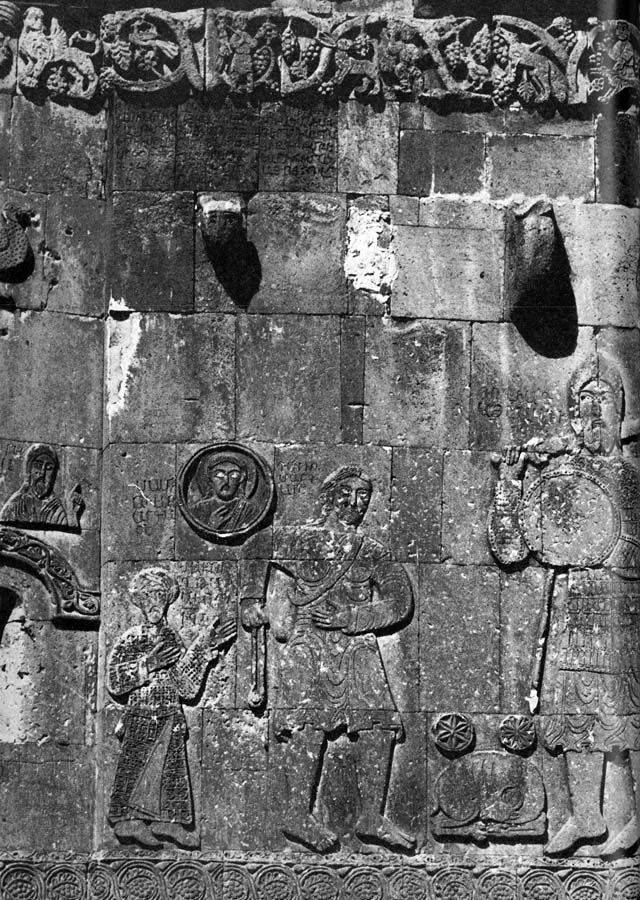
DAVID AND GOLIAF, the image on the wall of the Armenian church of 10 century on an island on Lake Van. Goliath is depicted with a drawn sword. David, with a sling ready to throw, is depicted too close to the Goliath; For the time-slayer of the time, throwing 250 yards was not unusual.
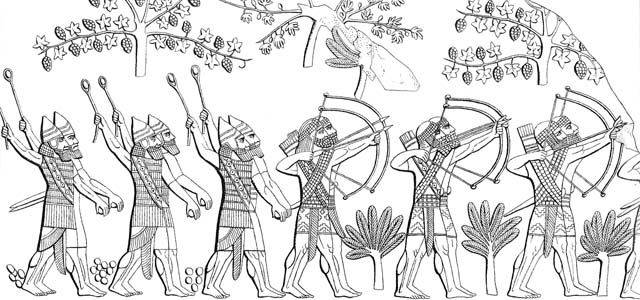
ASSIRYAN GUARDIANS, spinning slings in a vertical plane, are located behind the archers in this figure, based on the relief of Nineveh, depicting one of the campaigns of Sinaherib (704-681 BC). From this location on the battlefield, it can be assumed that they fired further than the archers.

SOLDIER OF THE ROMAN AUXILIARY TROOPS of times of wars with Dacians, with a sling at the ready, with a supply of stones in a raincoat, thrown over a hand with a shield. The drawing is made on the basis of images from the column of Trajan in Rome, erected in honor of the victories of this emperor.
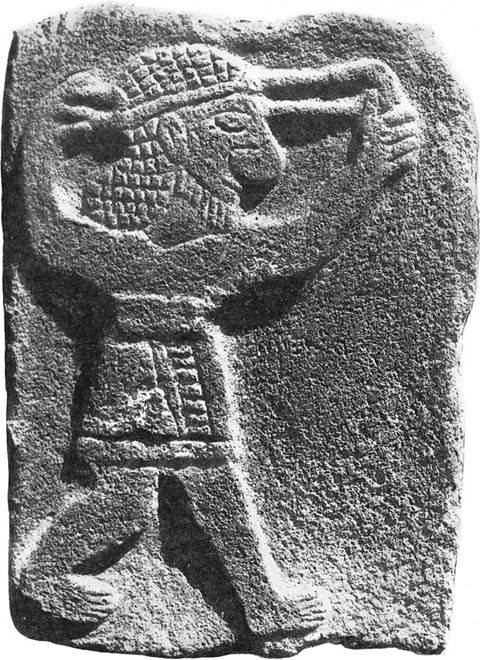
SOURCE STAND with a sling held overhead. The sculptural image of the Novokhettskaya slinger from Tel Khalaf in Syria, the ninth or eighth c. BC.
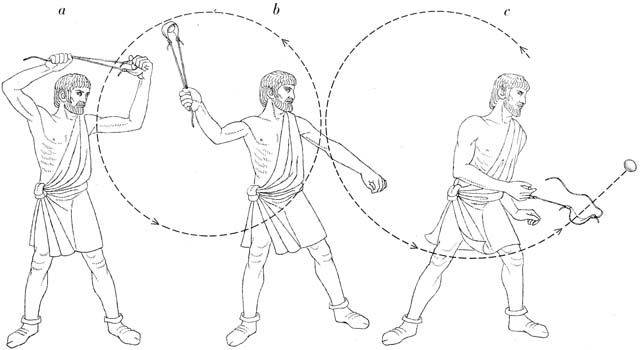
A MANUAL REMOVAL CAST begins (a) by charging the sling and preparing it for the throw: the sling end is wrapped around one finger and the free end is squeezed between the thumb and forefinger. Three or four turns anti-clockwise slings (b), which are made mainly by moving the wrists, and not the whole arm, give the projectile the highest speed. The projectile takes off (c) when the slinger releases the free end of the sling; at the beginning of a parabolic trajectory, its speed is over 60 miles per hour.
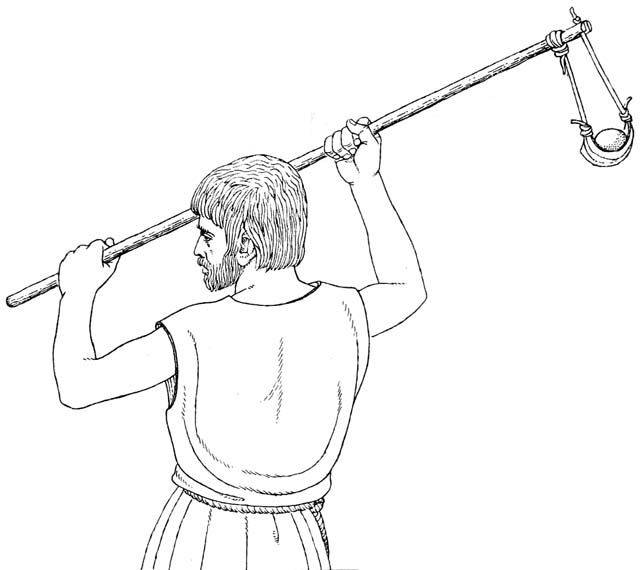
The throw from the fistula is made with a quick stroke of the sling from horizontal to vertical position. The free end of the short sling is placed in the recess at the end of the pole and slips out of it at the top of the stroke, freeing the projectile. The sling pole does not provide a throwing range from a hand sling, but it allows you to throw projectiles of greater weight, and is sometimes used to throw grenades.
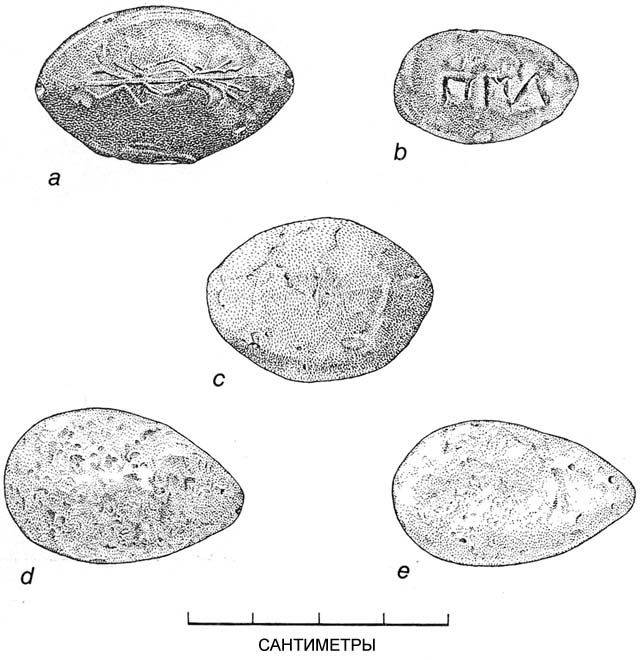
SHELLS, MANUFACTURED BY MAN (as opposed to pebbles), include large (a) and small (b) shells cast in molds. On a large projectile, Greek or Roman, there is a mark in the form of a lightning; a small projectile is one of hundreds found in Olyff, Greece. The third projectile (c) has a biconical form and is made of clay, dried in the sun. The remaining (d, e) are egg-shaped stones.
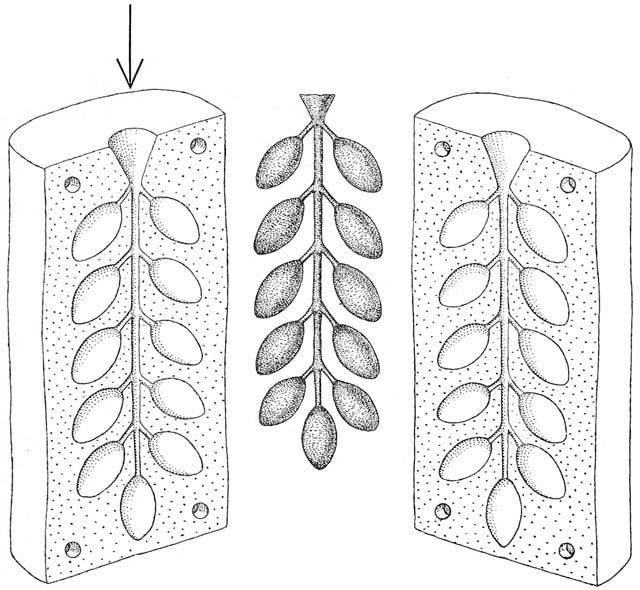
TERRACOTIC "tree" form was used for the simultaneous production of 11-ti lead shells. This reconstruction is based on a fragment of a form found in Olyff. Between the two halves of the form is shown a molded "tree" before the separation of shells from it.

OINTEF DEFENDER DETAILS since his siege of 348 BC weighed from 19,5 to 33,4 grams (colored marks). However, nine out of fourteen, weighed less than 27 grams. When their mass was compared with the mass of other projectiles found during Olinf excavations (gray marks), it turned out that most of the projectile defenders belong to the group of light and medium projectiles.
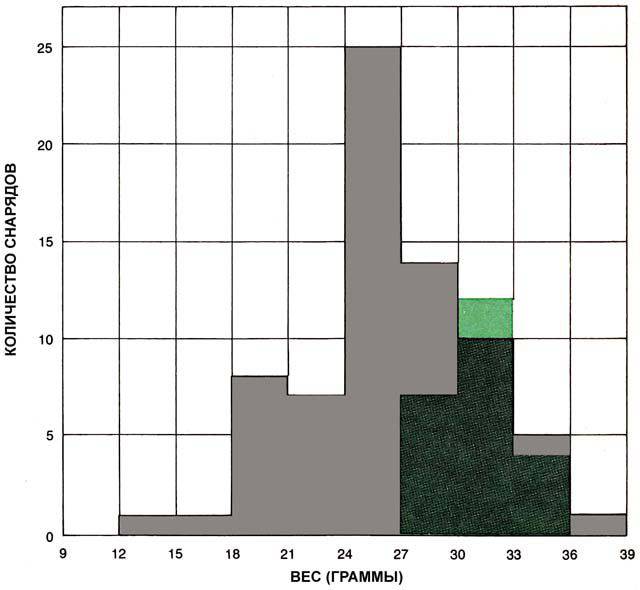
THE ATTACKING SQUARES in this siege weighed less than the shells of the defenders. From 23's shells, which can be defined as Macedonian, 16 weighs from 30 to 35,8 grams. Comparing them with other projectiles (gray marks), Macedonian shells can be attributed to a group of heavier projectiles.

DISTRIBUTION OF MEASURES IN THE WORLD from prehistoric time to the recent past (colored dots) suggests that there are several large areas on earth where the sling was not known. The early spread and importance of the sling in the Middle East and in Europe most likely makes it possible to speak of the spread of the art of throwing sling from these territories. If in the New World the slingshot was not invented independently, then its presence there can also serve as an argument in favor of the existence of certain connections with the Old World across the Pacific Ocean or the polar regions.
Publication:
Scientific American 229. October 1973, pp. 34-42; XLegio © 2010
Information